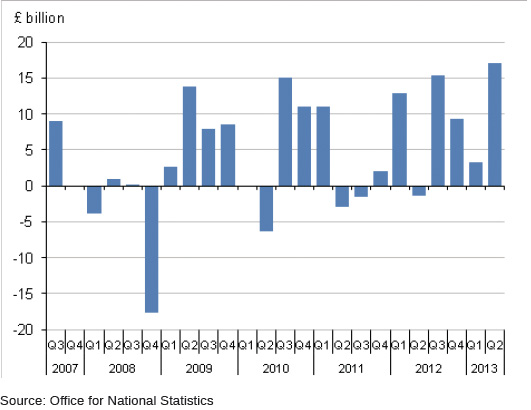News analysis: UK pension funds hit a record of £17bn of net investments during the second quarter, largely as a result of schemes taking advantage of lower bond prices, according to data from the Office for National Statistics.
Net investment was the highest quarterly figure since 2009, according to the data released on Friday. Respondents to the study reported high levels of gilt investment amounting to £6bn, a move the ONS suggested was down to pension funds switching back into fixed income to temper the effects of equity market volatility.
What’s changed in the past two or three years is that more pension funds have a [derisking] framework in place
The bond sell-off since last summer saw yields rise beyond what the market expected, with the Federal Reserve’s tapering announcement in May acting as a particular catalyst for the buying spike in Q2, said John Belgrove, senior consultant at Aon Hewitt. This resulted in many schemes hitting derisking triggers.
“When [schemes] see an opportunity to accelerate their journey, they’ll come in and get some,” he said. “There has been quite a meaningful rise in gilt yields over the course of this year.”
The yield on 20-year gilts rose 80 basis points to 3.4 per cent between the start of May and July 1, which had a significant impact on schemes’ funding levels, he said, adding: “All things being equal, [an] 0.8 per cent rise in gilt yields has something like a 15 per cent movement on the price of liabilities."

Schemes take derisking opportunity
The ONS research covered private sector schemes, funded local authority schemes and insurance-managed pension funds, and the pension scheme figures are extrapolated from a wider study that also includes insurance companies and trusts. It recorded total net investments for pension funds in 2012 to be £36bn.
Rob Gardner, co-chief executive at consultancy Redington, said many schemes will have been affected by both a nominal rate-based trigger and a funding trigger, leading them to bank profits from equities to buy gilts.
“The reason why these trigger mechanisms are so important is to build up the governance to take advantage of [market movements],” he said.
“What’s changed in the past two or three years is that more pension funds have a framework in place to… move quickly and effectively to a new asset allocation. They’re becoming a lot more nimble, a lot more agile.”
However, larger companies auto-enrolling new members into existing schemes will have accounted for some of the new money, but not necessarily the investments in gilts, said Brian Henderson, head of UK defined contribution and savings at consultancy Mercer.
He added the biggest factor was year-end deficit contributions made by larger employers working their way through the system.
“Bonds would be the obvious home for these in light of the general derisking,” he said. “[Q2 is] a bit too early to be tactical and [for the higher investment levels to be] down to the recent rise in yields and any perceived attractiveness based on valuations.”
Diversification continues to be a strong theme and “looking to make bonds work better” by using absolute return mandates and multi-asset credit, he added.
Index-linked gilts are receiving particular attention because schemes are seeking to better match their inflation risk, said Paul Sweeting, European head of strategy at JP Morgan Asset Management. “However, corporate bonds still offer better value than gilts for long-term investors,” he added.






















